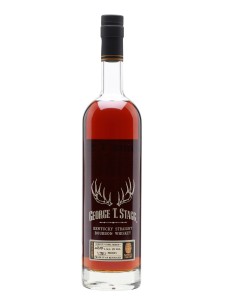By Richard Thomas
American limited edition whiskeys are fast becoming collectible items, and some of those terms I just used have implications. Most, but not all, limited edition whiskeys are akin to vintage wine, varying in their flavor profile from year to year. Collectibles command such high prices on the open market that it’s not uncommon to find bottles from past years still on sale.
George T. Stagg, that classic of modern ultra-aged bourbons, is an excellent example. The bourbon’s statement is that it is drawn from Buffalo Trace’s rye bourbon mash bill (as opposed to its wheated recipe), matured to 15 years or more (thus almost invariably beyond middle-aged) and bottled at cask strength. These qualities have made it prized with aficionados who treasure old, traditional recipe bourbon, and most enthusiasts see it as the flagship expression of the Buffalo Trace Antique Collection (BTAC).
All that said, George T. Stagg also varies quite a bit from year to year. Past the characteristics described above, Buffalo Trace isn’t trying to hit a particular profile in making Stagg. The flavor profile varies from year to year, and sometimes quite a bit. That is especially the case during the past decade, which saw the angel’s share for Stagg rise markedly.
Put all that together with the market value of a bottle of Stagg (retailer average of $799), and one thing becomes clear: anyone shelling out several hundred dollars on a variable bottle of bourbon should want a pretty good year for it. What follows are the four best releases, the top half so to speak, of George T. Stagg for the decade that ended with this autumn’s BTAC release.
Stagg 2010 (Market Value: $1,072): The decade started out well with this one, and not just because 2010 was still a time when you could put your name on a waiting list and probably get a bottle of Stagg at regular retail prices. Coming in at 143 proof (71.5% ABV), it was the kind of rich whiskey that makes “full-bodied” an understatement. Even after adding water, tasting it was like trying to sip on a 6-foot wave. It’s thick caramel core was surrounded by oodles of bananas and raising, sarsaparilla and spices like cinnamon, mint and clove.
Stagg 2014(Market Price: $942): This release put a darker, moodier twist on the expression. Coming out at 138.1 proof (69.05% ABV), it wasn’t as barrel-driven, sweet-forward in its profile as some Stagg expressions can be. Instead, the prolonged aging brought out a hoarier character. The first suggestion of this is in the crisp, woody aspect found in the nose. A sip brings on an earthy chocolate note coupled to dry, leathery wood that fully balances the deep sweetness and complimentary spice, becoming a third starring role in the performance.
Stagg 2015 (Market Price: $793): I was actually shocked when I looked up what the retailer average price was for George T. Stagg 2015; it’s below the average for the brand as a whole! The profile of this particular installment was different from 2010 and 2014 as well. It’s still an aged, somewhat woody bourbon, but the sweet side expresses itself with a more fruity than brown sugary character, still with all the vanilla one expects.
Stagg 2018 (Market Price: $533): This one is the cheapest of our top four, which isn’t surprising given that it’s also the most recent. It’s also the most well-balanced of the four, with pretty much even aspects of raisins and dried cherries; tannic, leathery oak; crisp rye spice; and melted brown sugar and vanilla sweetness. Although I didn’t rank this group of four in any particular order, I generally found less love for George T. Stagg 2018 out there than I did for the other three, although it still placed in the top half. My speculation is enthusiasts want Stagg to be a big, ballsy whiskey, but not so much that it doesn’t show complexity as well: a bruiser, but a Renaissance man as well. In 2010, 2014 and 2015, one aspect or another seemed to really jump out at people, but 2018 was too well-rounded for that. That plus the price point makes it the sleeper of the decade for Stagg.
 The Whiskey Reviewer A World of Whiskey, Poured Every Weekday
The Whiskey Reviewer A World of Whiskey, Poured Every Weekday


